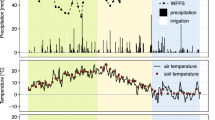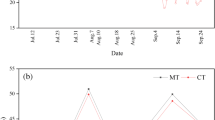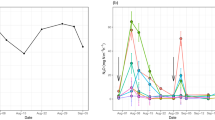Abstract
To increase the recovery of fertilizer nitrogen, reduction in the leaching loss of nitrate-N became a major challenge in nitrogen management in soil. A greenhouse experiment was conducted with maize to study the effect of dose of neem-leaf dust on transformation of nitrogen and the period of efficacy as nitrification inhibitor in a Vertic Epiaquept. The treatments comprised of neem-leaf dust @ 0, 500, 750 and 1000 mg kg−1 of soil at three frequencies, e.g., once at basal (0), in two equal splits at basal and 30 days after sowing and in three equal splits at 0, 30 and 60 days after sowing. Higher values of ammonium-N (7.2–10%) at all stages of sampling in neem-leaf treated soil than their corresponding control proved neem leaf as an effective nitrification inhibitor. Barring few exceptions, transformation/decrease in amino acid-, hexosamine-, total hydrolysable- and total-N was governed by the rate and frequency of neem-leaf dust application. Irrespective of dose and frequency of neem-leaf application there was a net build up of total non-hydrolysable-N. Both dose and frequency of neem-leaf dust application independently had a significant positive impact on dry matter yield and nitrogen uptake by maize. Application of neem-leaf dust at the rate of 600 mg kg−1 of soil in two equal splits was found to be the best combination for dry matter production as well as nitrogen nutrition of maize.

Similar content being viewed by others
References
Bouyoucos GJ (1927) The hydrometer as a new method for the mechanical analysis of soils. Soil Sci 23:343–353
Bremner JM (1965) Organic forms of nitrogen. In: Black CA (ed) Methods of soil analysis. Part 2. ASA, Wisconson, pp 1238–1255
Bremner JM, Keeney DR (1966) Determination of exchangeable ammonium, nitrate and nitrite by extraction distillation methods. Proc Soil Sci Soc Am 30:577–587
Jackson ML (1973) Soil chemical analysis. Prentice Hall of India Pvt., Ltd, New Delhi
Keith AK, Richard PW, Matthew D (2011) Potato response to nitrogen form and nitrification inhibitors. Am J Potato Res 88(6):459–469
Kim DG, Saggar S, Roudier P (2012) The effect of nitrification inhibitors on soil ammonia emissions in nitrogen managed soils: a meta-analysis. Nutr Cycl Agroecosyst 93(1):51–64
Kumar R, Devakumar C, Sharma V, Kakkar G, Kumar D, Panneerselvam P (2007) Influence of Physicochemical Parameters of Neem (Azadirachta indica A Juss) Oils on Nitrification Inhibition in Soil. J Agric Food Chem 55(4):1389–1393
Mukhopadhay AK, Saha D, Ghosh R (1985) Effect of ammonium producing nitrogenous fertilizers and N- serve on transformation of organic forms of nitrogen in soil under different incubating moisture levels. Trop Agric 62(2):157–160
NBSS & LUP (1985) Soil Map of India (1:7 million scales). National Bureau of Soil Survey and Land Use Planning Publication, Nagpur
Parashar KS, Prasad R, Sharma RP, Sharma SN, Singh S (1980) Efficiency of urea, nitrification inhibitor treated urea and slow release nitrogen fertilizers for sugarcane. Z Pflanzenernaehr Bodenkd 143:262–267
Patra DD, Anwar M, Chand S, Kiran U, Rajput DK, Kumar S (2002) Nimin and Mentha spicata oil as nitrification inhibitors for optimum yield of Japanese Mint. Commun Soil Sci Plant Anal 33(3–4):451–460
Qiu W, Hong JD, Keith CC, Hu C (2010) Nitrous oxide emissions from animal urine as affected by season and a nitrification inhibitor dicyandiamide. J Soils Sediments 10:1229–1235
Santhi SR, Palaniappan SP, Purushothaman D (1986) Influence of neem-leaf on nitrification in a lowland rice soil. Plant Soil 93(1):133–135
Sharma SN, Prasad R (1996) Use of nitrification inhibitors (neem and DCD) to increase N efficiency in maize-wheat cropping system. Fertil Res 44:169–175
Sigunga DO, Janosen BH, Oenema O (2000) Ammonia volatilization loss from Vertisols. Eur J Soil Sci 53(2):195–202
Smith LC, de Klein CAM, Monaghan RM, Catta WD (2007) The effectiveness of dicyandiamide in reducing nitrous oxide emission from cattle grazed, winter forage crop in Southland, New Zealand. Aus J Exp Agric 48(2):160–164
Author information
Authors and Affiliations
Corresponding author
Additional information
Publisher's Note
Springer Nature remains neutral with regard to jurisdictional claims in published maps and institutional affiliations.
Rights and permissions
About this article
Cite this article
Chakraborty, D., Pal, S.K. Effect of Dose and Residence Time of Neem-Leaf Dust as Nitrification Inhibitor on N-Transformation in Maize Soil. Agric Res 9, 577–584 (2020). https://doi.org/10.1007/s40003-020-00457-4
Received:
Accepted:
Published:
Issue Date:
DOI: https://doi.org/10.1007/s40003-020-00457-4




